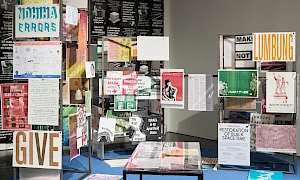Discomfort at Dinner: The role of food work in challenging empire
To open the publishing strand ‘Recette, Reset. Recipes In and Beyond the Institution’ writer Mary Fawzy’s reflects on the politics of food and food residencies within art worlds.
For something so physiologically necessary to human life, food is sometimes considered frivolous in conversations about politics, art and power. But from the beginning of civilization, food has defined more than just our survival. It has been the impetus behind migration, settlement, gender roles, wars and conquest. Food is so central to how we define ourselves as individuals and within cultures that many believers of the Abrahamic faiths would argue that humanity begins with the bite of an apple.
In the past couple of decades, more than ever, food has become a tool with which to communicate our cultural, environmental and political beliefs. With the rise of social media, tourism and food journalism (including heated cultural debates about which people invented hummus or jollof rice), food has become a popular medium for connection and education.
It’s no surprise, then, that artists, food workers, cultural workers and museums turn to food to engage visitors in their exhibitions, performances and public programmes. The most obvious workers who are using food to educate (both inside and outside museums and other institutions) are chefs and cooks, whose restaurants, food trucks, stalls and cafés double as classrooms all over the world. Immigrant chefs often choose to represent their heritage through their food, both wanting to feed those who are searching for comfort and connection through the foods of their cultures of origin, and hoping to invite in others who are curious to learn about their community. While immigrant communities face discrimination and marginalization in their new countries, their food sites frequently become avenues for social exchange.

Biatüwi dish called quinhapira, their signature dish. Fish cooked in cassava juice and served with crispy ants. Source: Biatüwi Instagram page
In other contexts, chefs work to preserve Indigenous food histories and foodways through showcasing erased or forgotten recipes on their menus. Clarinda Ramos and João Paulo Barreto, for example, are a couple who challenge societal ideas about the food they grew up eating in their Indigenous communities in the Amazon. Their restaurant, Biatuwi – Casa de Comida Indígena Manaus, in Manaus, Brazil, is the first restaurant in the city to serve only indigenous foods of the Amazon, including Maniwara ants, local chilis (like malagueta and jiquitaia), and meals made from indigenous plants like manioc and guaraná. Many of these ingredients come from the villages they grew up in, like the Tiquié River region, which can take several days of travel by boat to reach Manaus. People in the cities have long held racist stigmas about these traditional foods, associating them with poverty, and people from these communities who move to urban areas are often shamed for their food culture. ‘People have always made fun of the fact that I came from an aboriginal village,’ Ramos commented in Atlas Obscura’s food section. ‘We are seen as “undeveloped” compared to other societies, and our food is considered by many to be the kind only wild animals would eat.’ 1 Biatuwi’s mission is to educate via these foods and to dispel stigmas, while also instilling pride in Indigenous heritage, hiring Indigenous staff and using those traditional cooking methods and utensils that have been deemed ‘backward’ by modern Brazilian society.

Entrance to Tapi Tapi (inscription painted by Tapiwa Guzha). Photo: Mary Fawzy
In South Africa, meanwhile, food workers are also striving to educate about indigenous foods, even in a context where Indigenous people are the majority. Colonialism and its extension, apartheid, have largely erased indigenous foodways and ingredients to pave way for an agricultural industry based on European ingredients and culinary customs. Black cultural foods have largely been eliminated or deemed unacceptable in urbanized settings, and are mostly found in the less fertile and flood-prone peripheries, where Black people were forced to move and live during apartheid. One of the people working against these realities is Tapiwa Guzha, owner of Cape Town ice-cream cafe Tapi Tapi, which he considers to be an educational initiative. Using ingredients indigenous to Africa, Zimbabwean-born Guzha restores ideas about African food and presents them in the most pleasurable form of a sweet treat. He writes on the project’s website:
In part, Tapi Tapi is focused on rehabilitating the self-esteem of people from the continent about our food practices, as well as our culture and beliefs. I use food because it’s universal, people need to eat. So it’s a nice tool to get people to listen.2
The flavours are labelled according to the region they come from or marked ‘invasive’ if they originate in Europe or outside the African continent – an interesting statement for visitors trying to choose an ice cream. Guzha pointedly uses ingredients that may have been associated with poverty or relegated to a shameful status: baked clay, Kei apples, kapenta (salty dried fish), millet – all eaten and enjoyed extensively in southern Africa, but not found in most commercial supermarkets or acclaimed restaurants. While he is happy to educate tourists and people who aren’t familiar with the local ingredients, he says: ‘I’m not trying to appeal to the global universe – I’m trying to help Black identities enjoy their culture on a more regular basis.’3
Museums, in whose spaces food and drink is usually forbidden, have also partaken in this newfound culinary interest by incorporating food into exhibitions and events and by situating their cafés and restaurants as extensions of the museum experience. William Skinner writes, in the context of the opening of the Smithsonian’s National Museum of the American Indian: ‘A shift in the last quarter century, from museum cafeterias to museum restaurants, has corresponded to a change in perception from eating as an amenity to eating as an enhancement of a larger museum experience.’4 This relatively novel phenomenon is quite a departure from the old utilitarian standard of museum cafés/restaurants, disconnected from the institutional mandate. Such a shift helps reorient institutions away from ocular-centric approaches (which are exclusionary to blind and low-vision people) and towards experience-based artefacts, objects and rituals, to encompass smell and taste. Eating as learning makes for a multisensory educational experience.
Museum restaurants often focus on local ingredients, national cuisines and history, as well as drawing inspiration from whatever the museum is exhibiting at the time. Some museum restaurants have been so successful as to be awarded Michelin stars, such as The Modern at the Museum of Modern Art in New York, Mira Mira in Porto’s WOW (World of Wine) cultural district, and Nerua at Guggenheim Bilbao. The problem with these intentional fine-dining restaurants in cultural institutions is their exorbitant price and class barriers. While food labour and culinary skills should surely be given a high value, museums, even if private, still carry the connotation of being a public good, containing knowledge and archives that should be relatively accessible to all. In this sense, there is an incompatibility between the luxury status of exclusive museum restaurants and the social contract of being of benefit to the museum-going public.
Another tension of museum restaurants in countries that have profited from empire is their reinforcement of imperial heritage, especially given that many objects and artefacts held by these museums were procured unethically through plunder. Art historian Mark Clintberg has written about the case of the V&A Café, in the Victoria and Albert Museum, London, which portrays a menu of internationalism, with dishes from the parts of the world represented in the museum’s collections.5 Foods from India, the Middle East and parts of Africa are served alongside traditional British foods like scones and cottage pie, giving an air of British culture with a side of cosmopolitanism. Yet the communities that constitute British ‘cosmopolitanism’ reflect the history of British colonialism, the violences of which go unmentioned. The attempt of the eating establishment to appear cosmopolitan while being an extension of a museum built on colonial theft therefore makes for cognitive dissonance. Calls have been made from multiple formerly colonized countries to have their artefacts returned to them from European museums, with much resistance from the museums to do so. In such cases, the museum restaurant uncritically reproduces the colonial legacies of the museum itself.

Trout from Northern Woodlands as served at Mitsitam
In contrast, the Mitsitam Cafe in the aforementioned National Museum of the American Indian in Washington, DC, celebrates the food of Native American culture across the Americas, and creates a place for learning about and reclaiming foodways, ingredients and traditions lost to brutal genocide. As the restaurant’s website states: ‘Beyond just being a place to eat, Mitsitam Cafe seeks to educate visitors about the history of Native peoples, their connection to the land, and their rich and diverse cultures. Ingredients are often locally sourced, and traditional methods of preparation are used.’6 The restaurant, led by Navajo chef Freddie Bitsoie (along with executive chef Richard Hetzler), ethically sources foods like buffalo from the InterTribal Bison Cooperative, who, according to their mission statement, are ‘committed to reestablishing buffalo herds on Tribal lands in a manner that promotes cultural enhancement, spiritual revitalization, ecological restoration, and economic development.’7 In a country where the food of Native peoples barely enters the national consciousness, this is a space that not only educates, but also preserves and furthers indigenous cuisine.
From the 1980s to the 2020s, many museums based entirely on food have been established, such as the Museum of Food and Drink (MOFAD) in Brooklyn, New York; the Shin-Yokohama Ramen Museum in Yokohama, Japan; and the Museum Kimchikan in Seoul, among many others. These museum projects signal how food has become a route to exploring complex subjects and to instigating conversations between artists, educators and museological institutions. Food, whether eaten or visually exhibited, can trigger strong reactions and be a means of stimulating excitement, curiosity, dialogue and new insights. It also serves as an accessible ‘way in’ to sociopolitical issues such as migration, inequality, racism, colonialism and war. As Professor of Critical Heritage and Memory Susannah Eckersley writes: ‘[Food’s] everyday, appealing nature can enable the articulation of social values, culture, demographics, and identity in a way that is subtle yet simple, so that visitors may understand complex or otherwise “difficult” political issues in recognizable and emotive form.’8

Museum of European Cultures in Berlin / Museum Europäischer Kulturen (MEK)
One of the common ways museums, particularly in Europe, have engaged in sensitive topics is by highlighting the historical circumstances that have contributed towards the presence of immigrant communities in their nations. Amid rising anti-immigrant sentiment and policies in Europe, museums attempt to positively show the contributions of immigrant communities to society through food. In 2009–10, the Museum Europäischer Kulturen (Museum of European Cultures) in Berlin held an exhibition on the migrant economy with a focus on how the Turkish population have shaped Berlin’s fast-food scene through the invention of the Döner kebab.9 The concept of a kebab in bread was first introduced in Berlin, not Turkey, by first-wave Turkish migrants who had arrived as Gastarbeiter (guest workers) at the invitation of the West German government from 1955, in order to meet the gap in the labour market following the Second World War. The exhibition also documented the ugly history of the derogatorily named ‘Döner killings’, a wave of murders committed against Turkish restaurant owners between 2000 and 2006 by members of a neo-Nazi terror cell.10 Eckersley discusses the exhibition in terms of how the museum here takes a political position: the kebab display isn’t included to correspond with an ideology of ‘happy multiculturalism’, but rather as a way to discuss racism against Turkish immigrants.11 The fact that German citizens were responsible for the murders, she writes, ‘and not as a result of victim complicity in organized crime as had been assumed initially by the police, highlighted not only the issue of far-right terrorism within Europe, but also the presence of racism and prejudice within the German police and society.’12

Exhibition poster, ‘Le grand Mezzé’, 19 May 2021 – 6 May 2024, Mucem, Marseille
To give a contrasting example, the exhibition ‘Le grand Mezzé’ (The Great Mezze) at Mucem (Museum of European and Mediterranean Civilizations) in Marseille (2021–24) traces the history and evolution of Mediterranean foodways. Although it manages to proportionately represent Southern and Eastern Mediterranean contributions to European cuisine (often ignored in conversations about the popular food of the Mediterranean), it doesn’t make any connection to those communities just outside the walls of the museum, who continue to be subject to racial discrimination and abuse in France. Considering the diverse demographics of Marseille, home to one of the largest North African diasporas, Mucem would – or should – be well-positioned for a discussion on migration to the port city as a direct result of French colonialism.

Oysters à la Microplastique – Polycrisis Pantry, 2023, Zayaan Khan in collaboration with Maya Marshak and Maria van Zyl
Using food to broach political topics is a powerful tool, and one that artists may be able to take further than museological institutions, which may be compromised by national and state narratives, and are generally perceived as places for combined learning and entertainment, fit for fun school trips and tourist itineraries. Artists, whether hosted by museums or galleries or working independently, bring food into their work or make ‘performance dinners’ in order to disrupt norms around how we conceive of practices and cultures of eating. In 2023 Cape Town–based artist and food justice worker Zayaan Khan held a dinner in collaboration with Maya Marshak and Maria van Zyl called ‘The Polycrisis Pantry’, as part of the South African Urban Food and Farming Trust’s ‘Food Dialogues’ series. As she described it to potential guests: ‘Over multiple courses you will engage with the several interrelated and confounding crises – climate, environment, electricity, water, ideologies and beyond – as they impact directly on our plates and in our bodies.’13 Khan served, with a side of irony, ‘Oysters à la microplastique’: ‘Fresh oysters served with simple kelp bouillon to allow the inorganic profile of the microplastics to shine.’14 The tiny colourful ‘plastic’ pieces were in fact candies, but diners weren’t sure if indeed they were plastic or edible, and Khan chose not to clarify. Some diners skipped certain dishes they were too nervous to try, while others enjoyed them and reported that all was edible – and delicious.

Fire on the Mountain. Mountain kudu tartare, presented as a mountain that has been continually burnt to a crisp, on a bed of (plant) blood. Dusted with edible ash and served with whipped herbal butter, Afromontane forest and wholegrain sandstone crispbread. Polycrisis Pantry, by Zayaan Khan in collaboration with Maya Marshak and Maria van Zyl, 2023
Khan is one among a world of artists, activists and educators using food to stir the imagination and confront people with how capitalist forces and neoliberal politics influence our physical wellbeing, memories, and identity through what we eat. Little is more intimate than what we put inside our bodies. When it comes to museological institutions, food can be an emotive and palpable way to grapple with difficult histories. As Eckersley underlines, ‘[food] acts as an Ersatz [a substitute] both for direct political statements and for overt positioning by museums and heritage sites, particularly those which operate within a political realm that is not always sympathetic.’15 In this sense, food as a multisensory medium provides great possibility for museums to promote cultural memory and dignity, and to dismantle hegemonic narratives that perpetuate harmful propaganda and policies against marginalized identities, whether it be due to race, class, religion, gender identity, sexuality or language, through a digestible, impactful use of food.
The views and opinions published here mirror the principles of academic freedom and do not necessarily reflect the views or positions of the L'Internationale confederation and its members.
Related activities
Tongue and Throat Memories
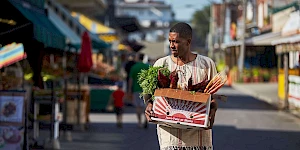
On hospitality and conviviality through food
Knowledges and convenings
Cooking Sessions
The Open Kitchen. The fermented seed, colonialism and extractivism
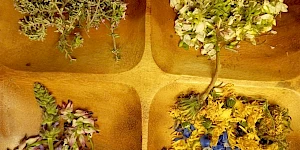
The MACBA Kitchen is a working group situated against the backdrop of ecosocial crisis. Participants in the group aim to highlight the importance of intuitively imagining an ecofeminist kitchen, and take a particular interest in the wisdom of individuals, projects and experiences that work with dislocated knowledge in relation to food sovereignty.
The Kitchen: Workshop by Marina Monsonís
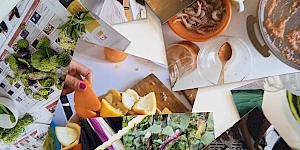
The Kitchen is a meeting place open to the participation of all, especially people and organizations that want to share their knowledge and experiences around the kitchen.
Multicultural Youth Center
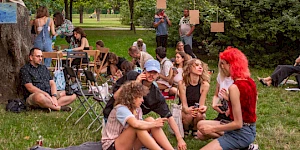
The Museum of Modern Art in Warsaw, together with the confederation of museums L'Internationale, is establishing a Multicultural Youth Center. This is a unique space for 16-24 year olds to explore and develop their creativity, make new friends and hang out in a friendly and supportive environment.
Where are the Oases?

PEI OBERT seminar
with Kader Attia, Elvira Dyangani Ose, Max Jorge Hinderer Cruz, Emily Jacir, Achille Mbembe, Sarah Nuttall and Françoise Vergès
An oasis is the potential for life in an adverse environment.
Mobile Garden. A Place to Meet
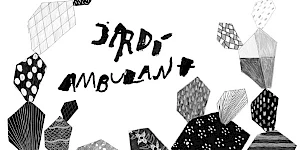
An open space, a social space. How could the Museum be more open to the needs of the neighbourhood?
School of Commoning Practices
This exchange programme gathers different schools organized by volunteers and migrant communities in Athens (Open School for Migrants) and Madrid (School of Rights, Escuela de Español and Situated mediation School) in order to share their knowledge, exchange strategies and reflect on the experience of working together with migrant communities.
Team of Teams
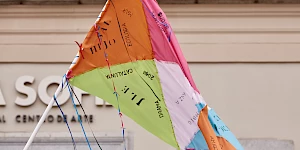
This project researches citizen participation as a fundamental pillar in the creation of community.
Sustainable Art Production
The Studies Center of Museo Reina Sofía will publish an open call for 4 residencies of artistic practice for projects that address the emergencies and challenges derived from the climate crisis such as food sovereignty, architecture and sustainability, communal practices, diasporas and exiles or ecological and political sustainability, among others.
SUPERHOST | Club Antena. Intimate listening and dancing experience
with Nele Möller, Farida Amadou, Le Réalism, Céline Gillain, Roberta Miss, Elena Colombi
CLUB ANTENA is an intimate listening and dancing session with a lecture, concert, performance, catering and DJ sets, exploring what it means to listen with our bodies.
Red, Green, Black and White
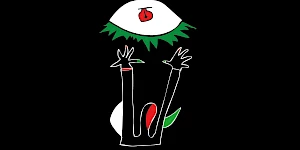
A performative inquiry by Institute of Radical Imagination and MSU Zagreb
Related contributions
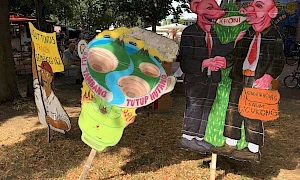
Lumbung practices to resist and collaborate through art
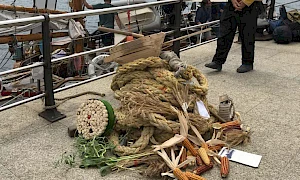
Some Guiding Terms for Lumbung Press: Defining “publishing”
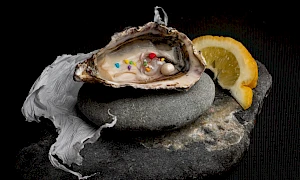
Discomfort at Dinner: The role of food work in challenging empire

Mix tape: Let's Funk Up All Genders!
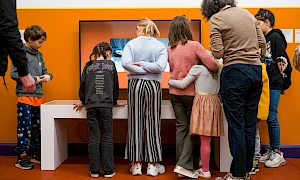
Towards Collective Learning, or, Decompartmentalizing Education
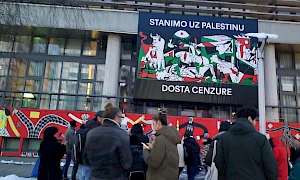
The Silence Has Been Unfolding For Too Long
